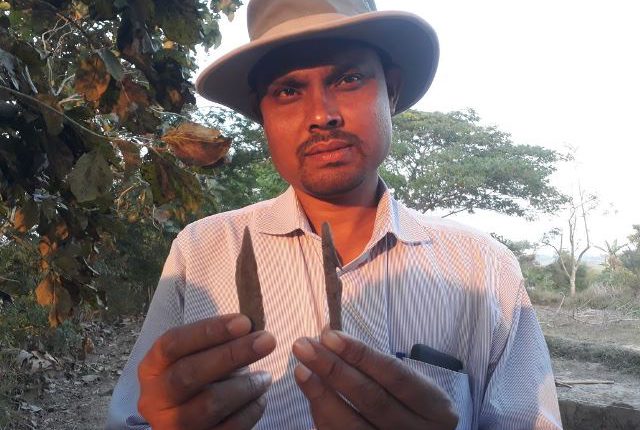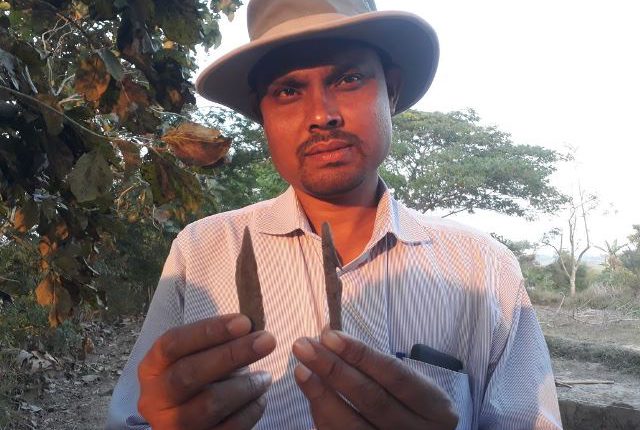For long as we remember, warfare has been a part of every civilization. Historical Weapons of Odisha From the earliest stone weapons to the modern guns and bombs, the idea has been to kill the opponent without dying yourself. Odisha is not an exception, and our civilization had also devised tools of killing for ourselves.
We are a tool making and using species. To highlight this aspect of ourselves, today we’ll discuss the historical weapons utilized by people in Odisha throughout history.
Prehistory
Before writing was invented, we used stone and wooden weapons to hunt prey. Food was the major consideration here. We also used the same tools for warfare between tribes.
In 2018, an excavation in the Prachi River Bank in Cuttack district unearthed weapons made of bone. These were dated to 4000 years ago, during the Chalcolithic period (the Copper Age).

In addition, Sambalpur University conducted an excavation in Bargarh district where stone tools and weapons were discovered. Dating back to the Stone Age (200,000 years ago), these tools and weapons indicate at an early civilization that existed in the region.
These weapons have mostly been stone axes and projectile points like arrowheads. Not many artifacts survive of those times so we are not sure what more weapons existed but warfare still existed.
You can read our another post on Bali Yatra: The Celebration of Maritime Splendor
Weapons During the Ashokan Period
When Ashoka came to conquer Kalinga, civilization was blooming in India. Iron and its alloys were in full use at the time. The armies of this era consisted of archers, infantry and cavalry. According to ancient Greek sources, when Alexander came to fight Porus, the king’s army had footmen, horse cavalry, chariots and war elephants.
Arrows of this era were mostly bone tips with some bronze and iron arrowheads available to select armies. This was because most of the footmen were unarmoured. The bowmen themselves carried wooden reflex bows. The infantry carried shields made of hide or Historical Weapons of Odisha wood and carried curved swords (talwar) as weapons. Cavalry weapons were spears tipped with leaf shaped iron spearheads and wooden javelins.
Kalinga’s armies had parity with Ashoka’s army as both had the same level of technical development, even though Kalinga’s army had more tribals.
Weapons of Mughal and Maratha Period
By the time the Mughals and Marathas rolled over the local rulers of Odisha, steel had become commonplace. The Mughals also brought Historical Weapons of Odisha with them a new form of war – gunpowder.
The artifacts of this era are much easier to find. We can see weapons of this age displayed in the Odisha State Museum in Bhubaneshwar. Historical Weapons of Odisha Their collection has talwars, banka churi (curved knife), daggers, early firearms and even some cannons.
The paiks who were the traditional soldiers in Odisha during the era also carried bows and arrows, bana(longsword), shields made of hide and Historical Weapons of Odisha wood and various kinds of edged weaponry. The armies of the Maratha and the Mughal Empires also carried matchlocks, early pistols and muskets.
Weapons During the British Occupation
Paiks continued to use traditional weaponry as they were cheaper and supply was plentiful. However, as time went on, they began fielding firearms as well, mostly matchlocks and flintlocks. The British brought with them better cannons and muskets. Historical Weapons of Odisha Traditional forts were no longer safe havens as these cannons could breach stone walls.

This era showed the decline of the traditional paik army and with them came the decline of traditional weaponry. Muskets gave way to rifles and more modern firearms, mostly used by the British. Revolutionaries increasingly began favouring modern weapons, leaving traditional weapons to the wayside.
Even with modernization, traditional weapons still survived, mostly because people knew how to make them. They were utilized by both freedom fighters and bandits, interspersed with modern firearms, as a way to save costs. They were still effective, though diminished in importance.
Weapons of Today
Modern firearms rule the day for law enforcement as well as antisocial elements. Traditional weaponry is now relegated to museums and performance arts. However, sometimes edged weaponry is still used in crimes, mostly because they are easier to get hold of than firearms and easily disposed as well.
Traditional edged weapons are now considered mostly obsolete, with bow and arrows being used for sports rather than a way of living. Society has advanced, so has our technology and with it the ways of killing. This post will not discuss modern weapons as they are not the focus this time.
More: Wanted to download Odishashop.com visit here
Conclusion
Odisha has rich history of civilization, from stone age right to the modern era. With advance in society, our ways of living have changed and so have our traditions. However, what has not changed is our nature. We are still people driven by interests, which conflict with other people’s interests. These conflicts have in the past led to violence and thus was the need for weapons. Today, we have better conflict resolution methods than before, so violence is not the first option anymore. The state now hold the monopoly of violence, law enforcement in other words.
We can now leave our violent past behind and use these weapons as lessons from history, rather than instruments of violence. However, do not forget that these were the tools we used to defend our freedom, our right of living. We should celebrate them as such and preserve them, so that the coming generations can undeerstand where we came from.

